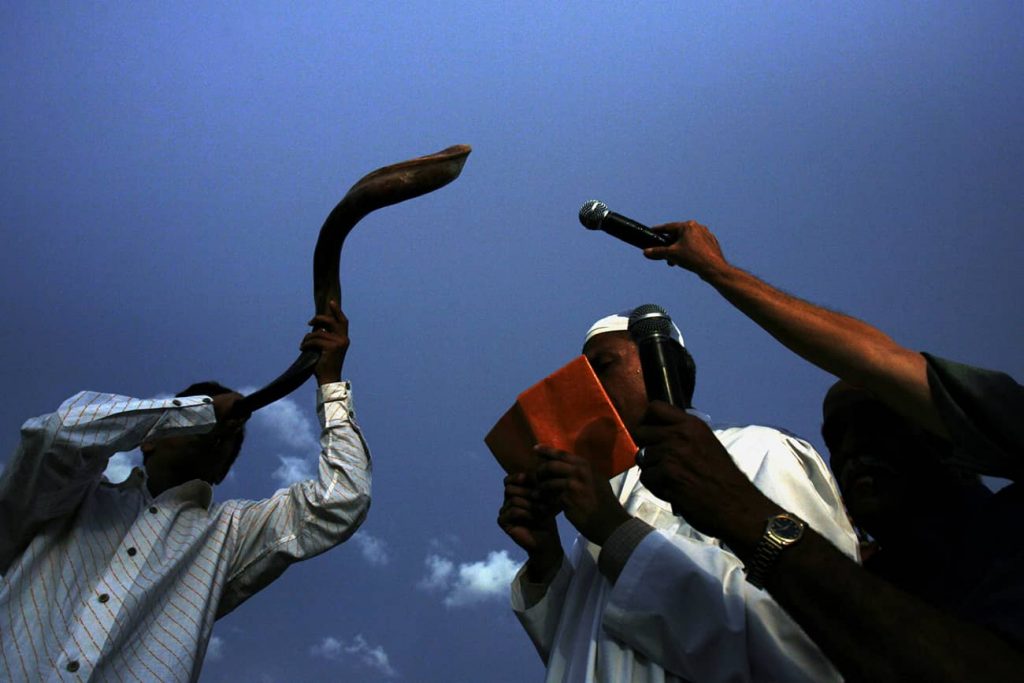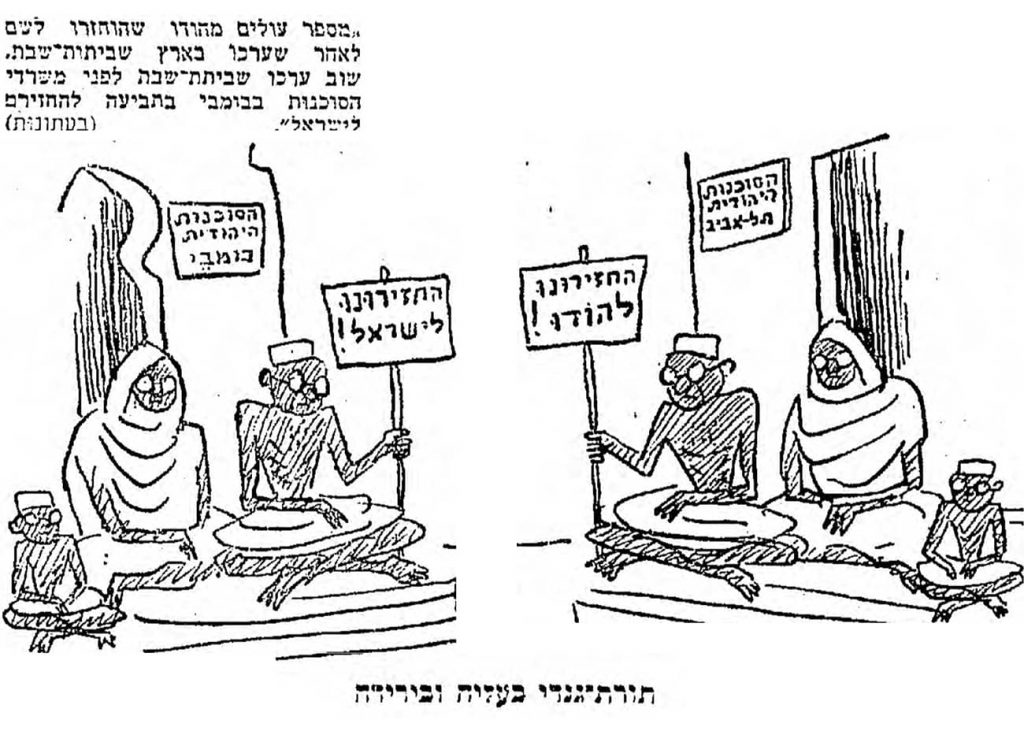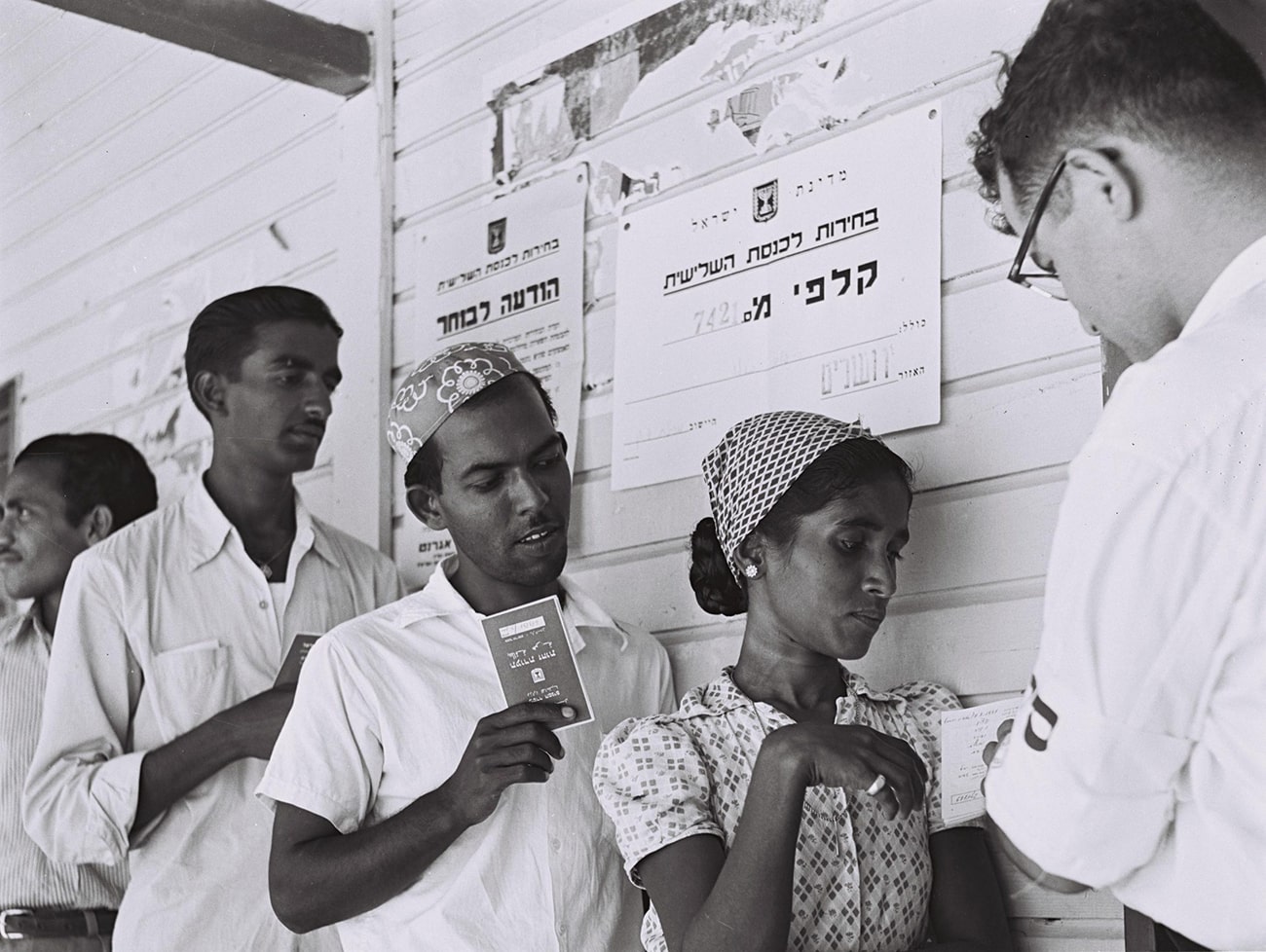In 1948, when the State of Israel was founded, waves of Jews from the three major centuries-old Jewish communities in India began to migrate to Israel, gradually forming a population of over 80,000 Jews of Indian origin in Israel today. Yet, strikingly, scholars of both Israel and the Indian diaspora have paid scant attention to the Indian Israeli community, and many in the public are also quite unaware of the story of the Indian Jewish migration to Israel and of the community’s contributions. In January 2022, India and Israel will celebrate the 30th anniversary of establishing formal relations, which provides an opportunity to take a look at a community that lives between the East and the Middle East.
With the establishment of the State of Israel, immigrants from various subcontinent groups began to immigrate to Israel and settled largely in the Israeli peripheral areas rather than in the urban core. Although in the Israeli landscape, Indian immigrants are perceived as quiet and unobtrusive, an in-depth look reveals a warrior community that has defined its own identity in a special way, refusing to hand over its cultural assets in the name of a prevailing assimilationist ethic and ultimately playing a role in forging the strong links between two very different yet increasingly friendly nations.
Who Are the Jews of India?
The Jews of India do not form one homogenous community but rather comprise five distinct ones, each with its history and social composition. The Bene Israel community from the Maharashtra area traces its history back to seven refugee couples who were ship-wrecked off the Konkan coast 2,200 years ago after migrating from Judea where they were persecuted under Greek rule. In India, they built their own community life according to the Jewish ritual practice and placed themselves outside the caste system. With the process of modernization of India in the 18th century, they began to migrate to Mumbai, Thane, and Pune and integrated into the British colonial administration. Today the Bene Israel is the largest of the five Indian Jewish communities. The second largest group is the Jews of Cochin. Ample evidence shows that this community lived in and around Cranganore from the 5th century CE to the 15th century. Some scholars, however, believe that they arrived in India at the time of King Solomon, although there is no evidence to support that early date.

The third group is the Baghdadi Jews, a well-known subgroup of Indian Jews despite their small numbers. Although Baghdadi traders visited India frequently during the medieval Abbasid Caliphate, they only settled in Mumbai in the late 18th century. These three distinct Jewish communities had little interaction; they spoke different languages, observed their own traditions, and were products of very distinct cultures. They also lived in three separate regions of India.
The fourth and fifth groups of Indian Jews—the Bene Efraim and the Bene Menashe—are also distinct, small communities with their own separate languages and customs. Bene Menashe are called the “North-East Indian Jews,” while the Bene Efraim are known as the “Telugu Jews” after the Telugu language of the province of Andhra Pradesh. This group lives in the southern part of the province, and its documented links to Judaism, like those of the Bene Menashe, date back no more than 70 years.
The story of Indian Jewish immigration, acculturation, and identity in Israel has only recently been researched. Although Indian Jews constitute a distinct ethnic group, there is also significant variation within this population in terms of levels of education and behavioral patterns, stemming from their areas of origin in India. A variety of factors influence the experience of immigration and the integration of immigrants in the destination country. In the case of the aliyah (the Hebrew term for Jewish immigration to Israel—literally meaning “ascent”) from India, one can point to two significant incidents that shaped the aliyah experience and the integration of the Indians in Israel: the first Satyagraha in Israel and the questioning of their Jewish legality.
Mahatma Gandhi’s Ideas Reach Tel Aviv
When Israel became a sovereign nation, it opened its borders to Jews from all across the globe. Between May 1948 and December 1951 alone, approximately 684,000 people immigrated into the new country—doubling the number of pre-independence Jews in the country. Never before had so many diverse cultures, languages, and ethnicities come together in such a confined geographical area over such a short period to form a new collective. However, the young state found it difficult to keep its promises, having painted an overly bright image for its future citizens. In his memoir, Shlomo Hillel, one of the leaders of the Iraqi Jewish community, described his conversation with future Prime Minister Levi Eshkol, who was at the time the treasurer of the Jewish Agency. Hillel expressed his enthusiasm about bringing more Iraqi Jews to Israel, but Eshkol replied: “tell the Jews to come, but not to rush to Israel.” Eshkol explained that his concern was with logistics—mainly housing the newcomers. Hillel responded he had no intention to delay the immigrants since the danger they faced in Iraq was probably greater than the challenges facing the immigrants in Israel. Although this was true for other immigrant groups as well and not just the ones from Iraq, the motive of the Indian Jews to immigrate, however, was mostly rooted in a combination of Zionist and religious sentiment together with economic factors.
The 1950s witnessed three main waves of Indian migration, mostly from the Bene Israel and the Baghdadi communities. In this decade, the initial meeting between the newcomers from India and the Israeli society took place. This was also the era of “the absorption protests.” Between the years 1949–1964, new immigrants initiated 65 out of the 326 total protest events, while 40% of those demonstrations were in response to economic issues. The “Indian Protest” was one of the first demonstrations organized by new immigrants, and it was the first protest charging the Israeli establishment with having a racial bias. On November 8, 1951, a group of newcomers who settled in Beer Sheva wrote the Jewish Agency in Tel Aviv and demanded their return to India within eight days or else they would start a hunger strike. In their letter, they complained of discrimination against their community in employment, housing, and medical care. The group also had serious grievances about education—their children were not admitted to educational settings and they were forced to send them to the mission school, which was open on Saturdays.

The new immigrants, who had experienced India’s struggle for independent rule and the great upheaval when the British departed, came to Israel equipped with a developed consciousness of protest. Gandhi developed the way of Satyagraha, which means “insistence on truth,” according to which man may and must resist any injustice, discrimination, or violence against him, but he must do so without causing any harm to the one who harms him on the physical level and also without displaying hatred toward him. Armed with a protest consciousness, although devoid of local language skills and personal connections, the Indians made a difference. The Bene Israel group reacted to unfair treatment and favoritism with a unique form of insurgency against Israeli authorities. The Bene Israel plight was widely noted, mostly for their ability to mobilize grassroots level activism and for their mastery at building non-governmental organizational support.
In an extraordinary initiative, the Indian Jews made good use of their skills in English, addressing government ministers, the British Consulate, the American Consulate, the Indian Prime Minister Jawaharlal Nehru, and the media. They brought their grievances to the international arena, with their story covered by Haaretz and the New York Times. Fearing the impact on the country’s image, Prime Minister Ben-Gurion eventually gave in and in April 1952 sent the 112 Indians back to India at the expense of the Jewish Agency. Ben-Gurion was convinced there was no other way to change the minds of passive hunger-strikers. Many consider this protest a great failure since some members of the group decided to return to Israel at their own expense a few years later; however, for future generations, this protest has been used to design the community’s own narrative and revival.
Jewish Legality
A decade after the anti-Indian discrimination protests had broken out, the Indian Jews in Israel became embroiled in a conflict with the chief rabbinate over their identity, born out of rivalry and competition between the different immigrant groups. In 1962 the Sephardic Chief Rabbi Itzhak Nissim issued a directive ordering rabbis in Israel to investigate the ancestry of the Bene Israel. Facing difficult conditions in adjusting to their new country and not having any support, doubting their Jewishness was a slap in their faces, since the community saw their Jewishness as a crucial element of their identity and the central motivational factor for immigrating to Israel. Unlike other communities from Eastern Europe and the Middle East, the Indians did not migrate to Israel due to a lack of security. The Indian community and its supporters accused the rabbinate of “racism,” arguing that Jews from affluent Western countries were not subject to such an extensive investigation before being permitted to marry other Jews. Here, too, the Indian community made clever use of lobbying and media pressure and their struggle again made headlines in the New York Times, which followed the case. After a demonstration in August 1964, Prime Minister Levi Eshkol convened a special session of the Knesset to pass a resolution supporting the Bene Israel position and demanding the removal of “every factor producing a feeling of discrimination.”
Although this case was settled in 1964, the insult and self-doubt affected the community and left a scar among those people who had experienced it at the time. Consequently, this crisis strengthened the community’s solidarity and reduced its desire to merge with Israeli society. In addition, the chief rabbinate’s skepticism continued to prevail, and despite official approval, some municipal chief rabbis refused to marry Indians with other Israeli citizens. It dawned on the members of the community that while in India they had not faced official discrimination, it was in Israel where they encountered prejudice toward their ethnicity.
The Present is Bright, but Work is Still Needed
The protests of the Indian community failed to compel the state to implement any changes regarding their conditions. Internalizing this, they turned to other sophisticated means—their own community. Community strategies were key in assisting the Indian Jewish migrants on two levels: First, the community served a functional role in organizing, decision making, and providing assistance to individuals; second, the community had a symbolic role in providing a sense of belonging, power, and identification, and it represented values and qualities that strengthened and supported the immigrants’ coping abilities. Community strategies were particularly effective because the settlement pattern of the Indian immigrants in the periphery was concentrated in certain cities.
Culture is the foundation that allows immigrants to live in peace with their past while incorporating cultural elements that originate in changing spaces. This was true in the first years of these communities in Israel and is still a firm truth in the digital age. Today, digital platforms, such as Facebook and TikTok, play a crucial role in transforming the way the Indian Jewish community in Israel interacts with its culture. They serve as important platforms in reaching varied audiences in the community, and they have a crucial impact on cultivating the unique identity of Indian Jews in Israel between the East and the Middle East. Indian Jews in Israel have assimilated into the Israeli society, while keeping their own distinct identity. The young generations especially are eager to adopt an Israeli way of life rather than remain distinctive from the rest of their society, as many of their ancestors did. In recent years, the community has placed a special emphasis on preserving Indian Jewish culture and their contribution to the mosaic of Israeli society. This is evident from the growing number of conferences and media coverage about their culture as well as about the mega project of the community, the Cochin Jewish Heritage Museum at Moshav Nevatim. Another important trend is the involvement of the weakest and underprivileged group in Indian culture—youth and women.
Israel’s government and society have traditionally placed Indian Jews in the Mizrahi bloc (Jews of Middle-Eastern and North African descent), but in recent years they have increasingly identified themselves in a separate category, as South Asians. Their social patterns, psychological characteristics, and culture all bear the marks of the Indian civilization within which they have lived for hundreds if not thousands of years.
The burgeoning bilateral relationship between Israel and India today has boosted the confidence of the community. The visit of Prime Minister Narendra Modi to Israel in 2017 increased the community’s publicity. Modi’s decision to host a rally of Indian Jews in the midst of an intense three-day visit helped inform Israeli society and decision makers of the importance of the community in the eyes of the Indian government. Since the early 2000s, the government of India has undergone an institutional and conceptual change in which the Indian diaspora has become an important tool in Indian foreign policy. At first, it was the affluent Indians in the West who were courted by the Indian government, but under the rule of the BJP, working-class diaspora communities, such as the Indians in the Gulf countries and in Israel, have become a significant part of the government’s foreign relations strategy.
Indian Jews have forged a somewhat fluid identity between the East and the Middle East. Although the 1950s protest is still subject to various interpretations as to whether it was a success or a failure, today, the absorption challenges of new immigrants from the Bene Menashe community, who come from a rural area of India, remain significant. The growing partnership between India and Israel should serve as an incentive to encourage research on the histories and cultures of Indian Jews. Such research would not only add to the understanding of the immigrant experience in Israel, as well in other Indian diaspora communities, but it will also shed light on the understanding of how cultural, religious, and national identities are taking shape across the two nations.

